At least for the time being, art is the primary way we experience dinosaurs. We can study bones and fossils, but barring the invention of time travel, we will never see how these animals lived with our own eyes. There are no photos or videos, of course, which means that if we want to picture how they look someone has to draw them.
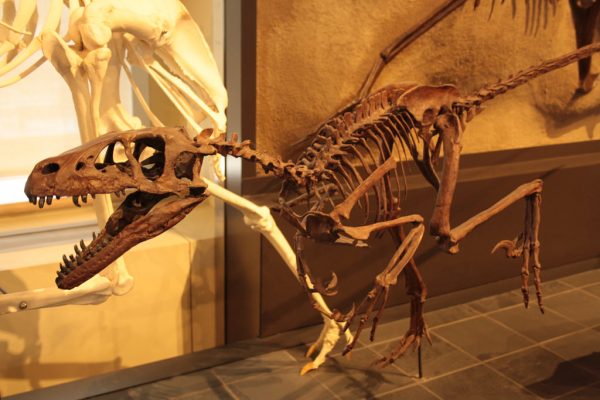 Photo by Shanker S. (CC BY 2.0)
Photo by Shanker S. (CC BY 2.0)
Bob Bakker became obsessed with dinosaurs at an early age and went on to become one of the most famous paleontologists in the world. He also happens to be a very skilled paleoartist, and over the years his writing and his illustrations have had a huge impact on how we think about and picture these prehistoric animals.
Hulking Masses of Flesh
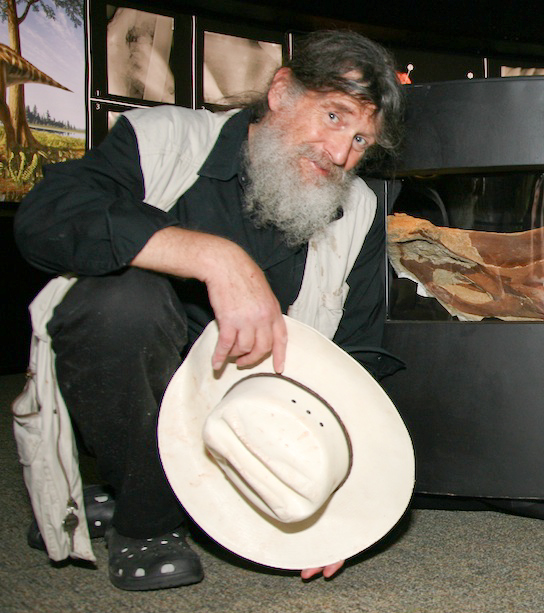 Dr. Bob Bakker, paleontologist and paleoartist
Dr. Bob Bakker, paleontologist and paleoartist
In the mid twentieth century, when Bakker first started college, American dinosaur science was in a bit of a rut. Dinosaurs were considered big, dumb, cold-blooded reptiles. They were thought of as evolutionary failures destined for extinction. And that view of dinosaurs affected how they were drawn. In most paintings of dinosaurs, the creatures were not moving or interacting with each other — there was no spark of intelligent social life. And their bodies were these hulking masses of flesh.
“The way brontosaurus and diplodocus (the biggest dinosaurs) were illustrated they were like giant, gray vacuum cleaners with very very short legs,” explains Bakker. “They were depicted slowly pulling themselves across the landscape or sitting neck deep in a fetid swamp. And that’s where we were in the early 1960s — dinosaurs were sad, cold blooded, dead ends in the history of life.”
But paleontology was about to go through a spectacular shift.
The Superiority of Dinosaurs
During Bakker’s freshman year at Yale, the geology department took him and some of the other students out on a dig. The trip was led by one of Bob’s professors, a paleontologist named Jon Ostrom. On the dig, they dug up a new species of raptor named Deinonychus.
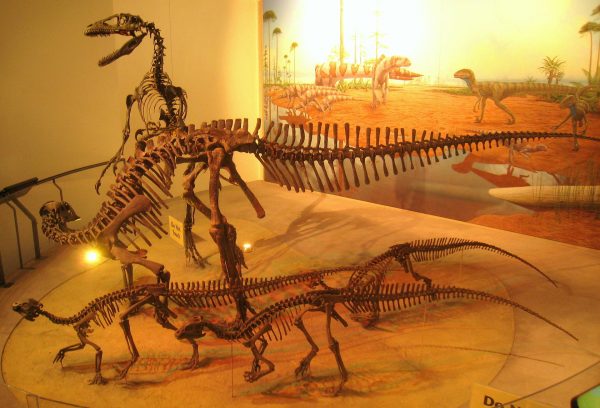 Exhibit showing Deinonychus attacking Tenontosaurus, Academy of Natural Sciences
Exhibit showing Deinonychus attacking Tenontosaurus, Academy of Natural Sciences
After studying the fossils back at Yale, Professor Ostrom began to argue that if you really looked at the anatomy of deinonychus and other dinosaurs they looked less like a lumbering lizards and more like a super athletic birds.
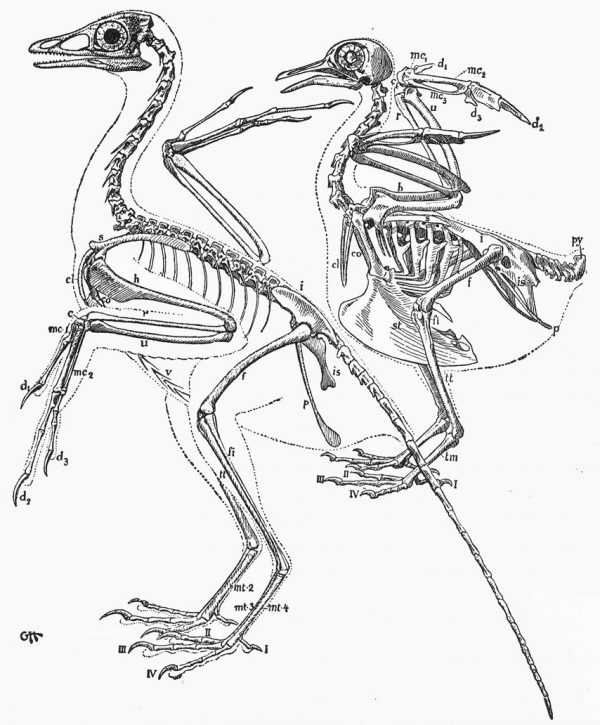 Archaeopteryx compared to the skeleton of a modern pigeon 1916
Archaeopteryx compared to the skeleton of a modern pigeon 1916
Bakker was fascinated by this idea. As an undergraduate, he dissected modern animals in an effort to better understand dinosaur musculature. He concluded that the old stereotypes about sluggish, stupid dinosaurs just didn’t hold up.
Bakker and Ostrom weren’t the first people to come to this conclusion. As the mid-19th century there had been scientists and religious thinkers who believed that dinosaurs were intelligent, active, and bird-like. But those ideas weren’t in the textbooks.
Bakker decided to publish a paper in a Yale journal, and his editor suggested he call it The Superiority of Dinosaurs. He loved that title idea. It embodied the idea that dinosaurs “weren’t evolutionary has-beens. They were top-of-the-line! They beat everybody!”
But convincing people that dinosaurs were actually totally different than they had been depicted for the past sixty years was going to require more than few good academic papers. To really change people’s minds, sometimes you gotta show instead of tell. Bob Bakker was a skilled illustrator as well as a scientist. So when Jon Ostrom wrote his definitive paper on Deinonychus, he asked Bakker to do the illustration. In the picture, the raptor is nearly parallel with the ground, it’s left leg springing forward, it’s right leg curled tightly against it’s torso, preparing for the next stride — it’s beautiful, and terrifying.
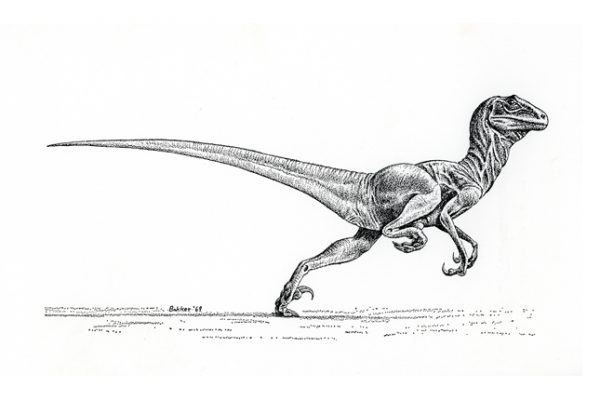 Deinonychus in full sprint, as drawn by Robert Bakker ’67
Deinonychus in full sprint, as drawn by Robert Bakker ’67
Bakker’s Deinonychus became an iconic drawing. No one had ever seen anything like it. Bakker went on to write academic and popular articles about how impressive dinosaurs had been, and he illustrated them all himself. He drew dinosaurs bounding across the prehistoric landscape like track and field stars with lithe, muscular bodies. And Bakker’s athletic dinosaurs became a model for other paleo artists like Gregory Paul.
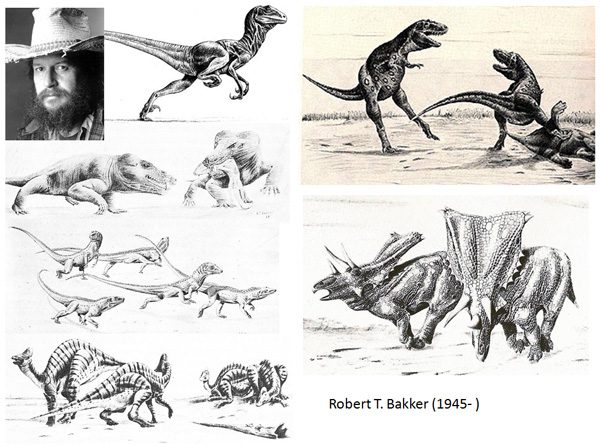 Robert Bakker’s athletic dinosaurs became the model for paleoart
Robert Bakker’s athletic dinosaurs became the model for paleoart
Dinosaur Renaissance
Throughout the 1970s, more and more paleontologists got on board with Ostrom and Bakker’s theories — they found new fossils and footprint evidence suggesting that dinosaurs had been warm-blooded, intelligent, and bird-like. This period has become known as the Dinosaur Renaissance, a moment when we totally rethought all of our assumptions about these incredible prehistoric animals. Paleontologists like Darren Naish think art was a huge part of its success: “I think that part of the reason that the dinosaurs of Dinosaur Renaissance the dinosaurs of Ostrom and Bakker … drew in so many scientists in the 60s and 70s was because [the era was] accompanied by brilliant visuals.”
If anyone missed out on this scientific revolution, and still thought that dinosaurs were slow and stupid, that ended in 1993 with the release of the film Jurassic Park. The dinosaurs in Jurassic Park are very… active.
When that movie came out the whole world got to see these fierce, athletic, creatures running through kitchens and eating lawyers off of toilets. Once you’ve seen the dinosaurs in Jurassic Park, you can’t unsee them.
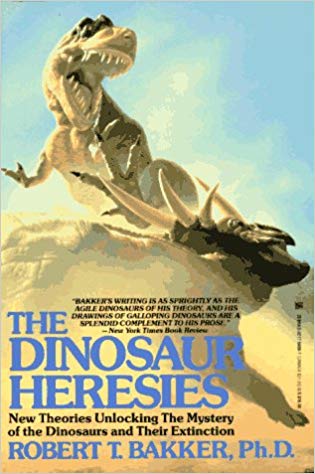
John Conway draws dinosaurs for a living, and he believes the film Jurassic Park cemented people’s idea of what a dinosaur is supposed to look like. Conway became interested in paleoart after reading Bob Bakker’s book The Dinosaur Heresies.
In the early part of his career, he drew dinosaurs that looked a lot like Bakker’s — lean and muscular. After a while, however, he says that all of his dinosaurs looked they had been shrink-wrapped. “You know those suction packs … you pack your clothes and you put the vacuum cleaner on it and you suck all the air out? That’s sort of what we’re doing with dinosaurs — we’re sort of putting skin on them and then vacuuming out anything that was in between that skin and the muscles.”
Now paleoartists weren’t just doing that to make their dinosaurs look all cool and buff. They were trying to be accurate. Accurate dinosaur art has to be rooted in real scientific evidence — and the main piece of evidence is often a skeleton. Paleoartists would base the shape of their dinosaurs on an accurate skeleton and then layer on muscles in appropriate places. Soft tissues like fat, however, often don’t survive for for millions of years like bone, and so artists tended to be pretty conservative about how much fat they gave their dinosaurs. The result was that all of these dinosaurs looked like the went to gym three times a day and drank protein shakes for every meal. John Conway says it began to feel as though paleoartists had replaced one orthodoxy with another.
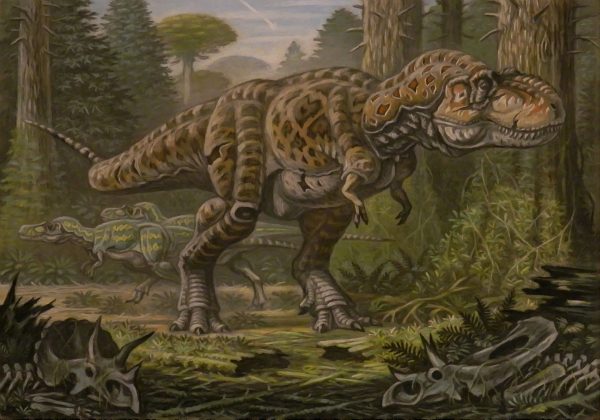
But just because fat didn’t survive for millions of years doesn’t mean that a dinosaur didn’t have it. Animals have fat and they have it all over the place and some places they have really big fat reserves which changes their shape fairly drastically.
To illustrate this point, think about trying to draw a modern animal, like a whale or a camel, just from their fossilized skeleton. It ends up looking really weird. If you draw a bowhead whale just from the skeleton, without a lot fat or blubber, it looks kind of like a giant tadpole with a bulbous head and long snake-like tail. It looks weird because a whale’s shape is defined by fat.

Dinosaurs also had fat, and Conway argues that it would have changed their shape pretty dramatically. “A dinosaur could have camels humps and we wouldn’t know because you can’t tell from a camel’s skeleton that it has humps,” says Conway. “Brontosaurus could have had humps we don’t know!”
Scientists do sometimes find dinosaurs fossils with the soft tissues intact, and when they do it can completely change our image of the animal. The dinosaur psittacosaurus, for example, used to be depicted in a standard, shrink-wrapped kind of way, until paleontologists found this amazing full body fossil where lots of the fat and the skin and the different soft tissues had been perfectly preserved.
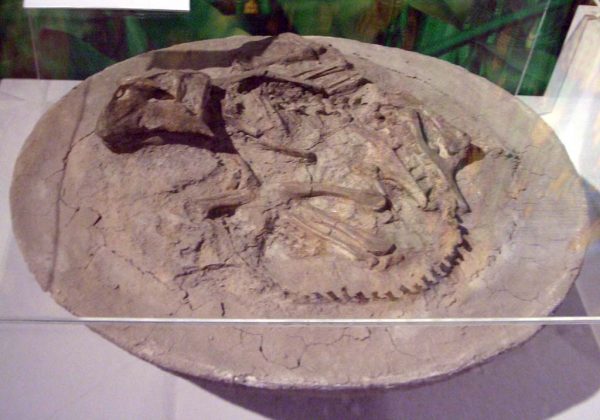 Psittacosaurus Fossil
Psittacosaurus Fossil
It turns out it was a kind of chubby creature with lots of striping, and long curving quills growing off the top of its tail.
In recent years fossils have been found with fat, and frills, and thick coats of feathers — way more than anyone had predicted. And this made John Conway wonder: if so many of the soft tissues we’ve discovered have been really strange, what about all the dinosaurs that we haven’t found any soft tissues for yet? “There are bizarre possibilities out there that no one’s looking at, and I thought well I’m going to start drawing some of these things.”

Conway began to try something new with his art — he started to speculate. He began drawing pudgy dinosaurs, and dinosaurs with weird skin flaps, and so many feathers they looked like birds. There was always a standard conservative dinosaur at the center of his drawings, but then he would cover it with more speculative elements.
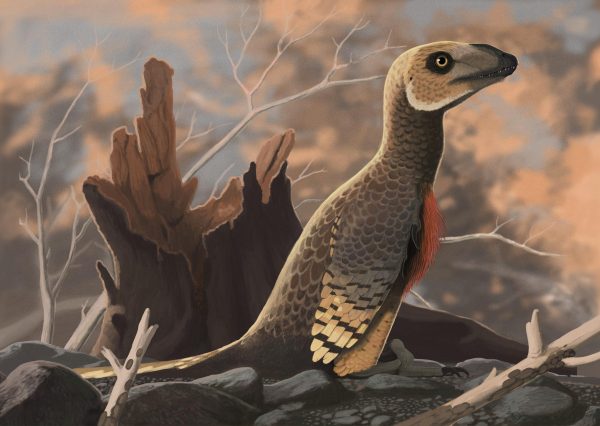 Deinonychus antirrhopus by John Conway
Deinonychus antirrhopus by John Conway
He wasn’t claiming that every dinosaur he was drawing was perfectly accurate, but he wanted to show people that dinosaurs as a group probably had a lot more weird variety than we tend to think. “In order to get the overall picture of dinosaurs right I think you need a healthy dose of speculation in there,” Conway says. That doesn’t mean anything goes. Conway is careful to say that dinosaur art should reflect the latest science—what we know for sure—but we’ll never know everything.
All Yesterdays
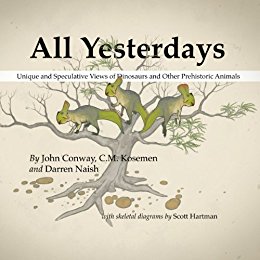
John Conway eventually decided to give the world a dose of speculation in the form of a book. He teamed up with Darren Naish and another paleoartist named Memo Koseman, and published a slim little paperback titled All Yesterdays: Unique and Speculative Views of Dinosaurs and Other Prehistoric Animals.
The book is filled with dinosaurs that look very different from what most people imagine. There’s a triceratops that’s covered in spines, a majungasaurus with skin that camouflages it against the forest floor, and a therizinosaurus that is so covered in feathers it looks like a haystack. And next to each image the artist describes why they drew it that way. The camouflaged dinosaur is drawn that way because the artists reasoned that it’s oddly-proportioned body might have made it vulnerable to predators and in need of a defense strategy.
All Yesterdays also tried to expand our understanding of dinosaur behavior. Usually when we see a fierce tyrannosaurus rex it’s attacking another dinosaur. But the dinosaur probably spent most of its time sleeping, and so that’s how John Conway drew it.
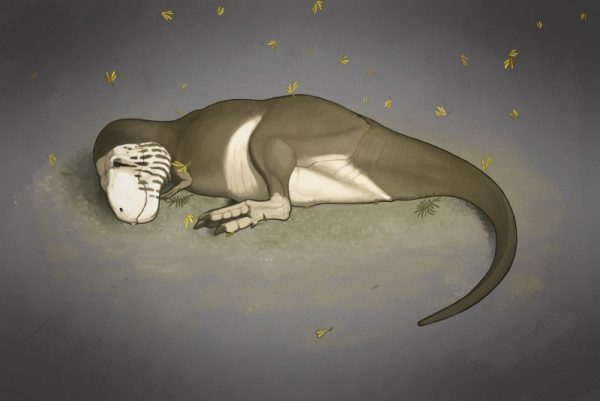 Sleepy stan by John Conway
Sleepy stan by John Conway
All Yesterdays was a real hit, and helped spark a little speculative movement within the paleoart community. Darren Naish says it’s more acceptable now to draw a dinosaur based on a hypothesis. For example, horned dinosaurs like triceratops have these large nostrils that have confused paleontologists for years. There have been a few different hypotheses put forward by scientists — one of them is that the dinosaur may have had inflatable nose balloons, almost like a hooded seal.
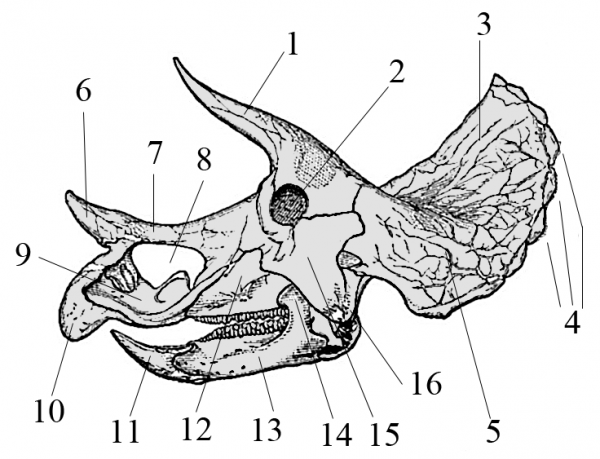 Triceratops skull with enlarged nostrils
Triceratops skull with enlarged nostrils
Twenty years ago, if someone were to draw a triceratops with nose balloons, they would have been laughed at. But Naish says that it’s now quite reasonable for an artist to depict the dinosaur that way as long they explain that choice. Of course, that doesn’t mean triceratops definitely had nose balloons!
But by drawing it that way, it’s like the artist is asking us to keep an open mind. Because even though we know a lot about the prehistoric world, the science is always changing. The past is always a moving a target.

 You probably know orchids as the big, colorful flowers found in grocery stores and given as housewarming gifts. But those tropical beauties represent only a fraction of the estimated 25,000 orchid species worldwide. While their showy relatives fly off the shelves, North America’s more understated native orchids are disappearing in the wild. Scientists at the Smithsonian Environmental Research Center are working to protect these orchids and their habitats, but first they need solve a surprisingly difficult problem: how to grow one.
You probably know orchids as the big, colorful flowers found in grocery stores and given as housewarming gifts. But those tropical beauties represent only a fraction of the estimated 25,000 orchid species worldwide. While their showy relatives fly off the shelves, North America’s more understated native orchids are disappearing in the wild. Scientists at the Smithsonian Environmental Research Center are working to protect these orchids and their habitats, but first they need solve a surprisingly difficult problem: how to grow one.


 We will all get old one day. Mike Sager’s astonishingly intimate portrait of Glenn Sandberg, age ninety-two, is about what it actually feels like to be close to the end. It’s a story about mortality and love and companionship and the things in life that matter most—and how those things we once held as so important fall away.
We will all get old one day. Mike Sager’s astonishingly intimate portrait of Glenn Sandberg, age ninety-two, is about what it actually feels like to be close to the end. It’s a story about mortality and love and companionship and the things in life that matter most—and how those things we once held as so important fall away.  How do we spruce up our LinkedIn profiles in order to stand out from the herd? Allison Nunes, workshop ambassador for LinkedIn’s “Rock Your Profile” program shares all her secrets. We cover job alerts, networking, applying for jobs, perfecting your profile, getting recommendations, and so much more. In Mailbag, we talk about online savings accounts, women bonding together in retirement (Golden Girls style), and buying a historic home.
How do we spruce up our LinkedIn profiles in order to stand out from the herd? Allison Nunes, workshop ambassador for LinkedIn’s “Rock Your Profile” program shares all her secrets. We cover job alerts, networking, applying for jobs, perfecting your profile, getting recommendations, and so much more. In Mailbag, we talk about online savings accounts, women bonding together in retirement (Golden Girls style), and buying a historic home.

 Alvin Toffler and Margaret Mead: an author and an anthropologist who endeavored to understand the impact of scientific invention. In this episode of our series, The Experimenters, we hear from two visionaries who believed that while we’ve started a technological revolution, we don’t quite know where it’s going to take us. But maybe most interesting of all – we get to hearing these archival interviews from the very future these thinkers were trying to imagine. Mead and Toffler guide us into a view of what the present might have been — or perhaps in some ways actually came to pass.
Alvin Toffler and Margaret Mead: an author and an anthropologist who endeavored to understand the impact of scientific invention. In this episode of our series, The Experimenters, we hear from two visionaries who believed that while we’ve started a technological revolution, we don’t quite know where it’s going to take us. But maybe most interesting of all – we get to hearing these archival interviews from the very future these thinkers were trying to imagine. Mead and Toffler guide us into a view of what the present might have been — or perhaps in some ways actually came to pass.
 Head underground to hear how the first subways were built, and how they are built today.
Head underground to hear how the first subways were built, and how they are built today.

 In "The White Elephant,” Yochai Maital walks us through the history of Tel Aviv’s ‘New’ Central Bus Station — a derelict eight-story behemoth and modern day Tower of Babel — which mirrors much of modern Israeli history, with its grand vision and messy implementation.
In "The White Elephant,” Yochai Maital walks us through the history of Tel Aviv’s ‘New’ Central Bus Station — a derelict eight-story behemoth and modern day Tower of Babel — which mirrors much of modern Israeli history, with its grand vision and messy implementation.


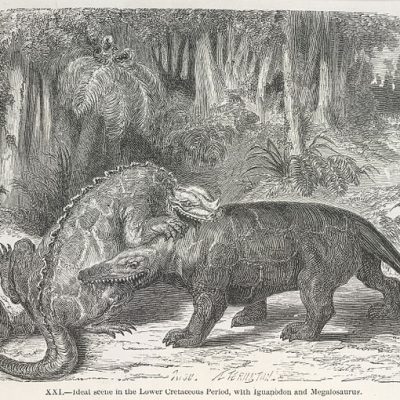
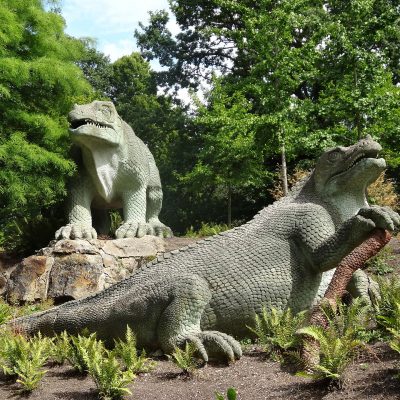
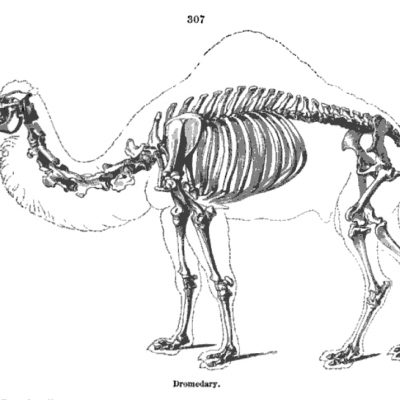
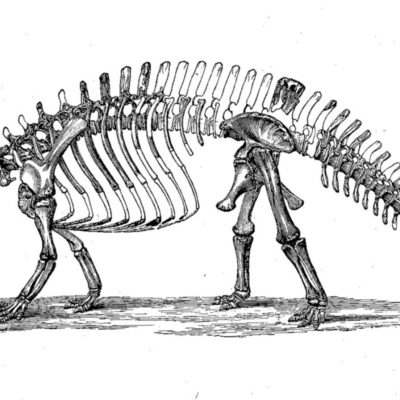

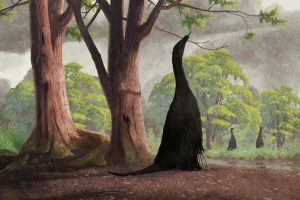


 Every week since September 1989, a radio station in Finland has broadcast a weekly news bulletin...in Latin.
Every week since September 1989, a radio station in Finland has broadcast a weekly news bulletin...in Latin. From those who "Hung Tough" to those who "Wanted It That Way," fan-girls share stories of their biggest boy band obsessions -- with a very special appearance from a boy band icon. As well as cameos by Song Exploder's Hrishikesh Hirway, Answer Me This' Martin Austwick & The Memory Palace's Nate Dimeo. The Mortified Podcast is a proud member of Radiotopia from PRX. Listen @ getmortified.com/podcast
From those who "Hung Tough" to those who "Wanted It That Way," fan-girls share stories of their biggest boy band obsessions -- with a very special appearance from a boy band icon. As well as cameos by Song Exploder's Hrishikesh Hirway, Answer Me This' Martin Austwick & The Memory Palace's Nate Dimeo. The Mortified Podcast is a proud member of Radiotopia from PRX. Listen @ getmortified.com/podcast
 "Peregrinar" is about a march led by Cesar Chavez.
"Peregrinar" is about a march led by Cesar Chavez.

 Photographer Robert Burley takes pictures of the end of analog for his book The Disappearance Of Darkness. Christine Frohnert and Christiane Paul explain why it is difficult to care for digital artworks and Social Media theorist Nathan Jurgenson wants us to understand what is truly revolutionary about ephemeral photographs and platforms like Snapchat.
Photographer Robert Burley takes pictures of the end of analog for his book The Disappearance Of Darkness. Christine Frohnert and Christiane Paul explain why it is difficult to care for digital artworks and Social Media theorist Nathan Jurgenson wants us to understand what is truly revolutionary about ephemeral photographs and platforms like Snapchat.

 Back in 1919, Walter Backerman's grandfather delivered seltzer by horse and wagon on Manhattan's Lower East Side. Today, Walter continues to deliver seltzer around the streets of New York. Some customers, like Mildred Blitz, have been on the family route for more than 50 years. When Walter's grandfather drove his cart there were thousands of seltzer men in the city; today Walter is one of the last.
Back in 1919, Walter Backerman's grandfather delivered seltzer by horse and wagon on Manhattan's Lower East Side. Today, Walter continues to deliver seltzer around the streets of New York. Some customers, like Mildred Blitz, have been on the family route for more than 50 years. When Walter's grandfather drove his cart there were thousands of seltzer men in the city; today Walter is one of the last.

 In this Out of the Blocks excerpt, we feature
In this Out of the Blocks excerpt, we feature